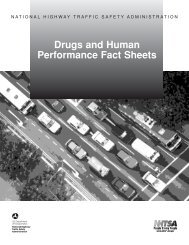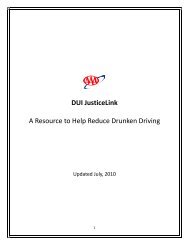2007 National Roadside Survey of Alcohol and Drug Use by Drivers
2007 National Roadside Survey of Alcohol and Drug Use by Drivers
2007 National Roadside Survey of Alcohol and Drug Use by Drivers
Create successful ePaper yourself
Turn your PDF publications into a flip-book with our unique Google optimized e-Paper software.
<strong>2007</strong> <strong>National</strong> <strong>Roadside</strong> <strong>Survey</strong> <strong>of</strong> <strong>Alcohol</strong> <strong>and</strong> <strong>Drug</strong> <strong>Use</strong> <strong>by</strong> <strong>Drivers</strong>: <strong>Drug</strong> ResultsOf particular interest may be the prevalence estimates for relatively frequently encountered drugssuch as marijuana. Marijuana (<strong>and</strong> its metabolites) appears as a separate drug class in thetypology presented in Table 17 <strong>and</strong> used in the subsequent tabulations <strong>of</strong> results <strong>by</strong> drug class.However, a number <strong>of</strong> drivers tested positive for more than one drug class (sometimes includingmarijuana) <strong>and</strong> were classified as such in the tabulations. Thus, drivers who were positive formarijuana were split between the mutually exclusive classifications <strong>of</strong> “marijuana” <strong>and</strong> “morethan one drug class” in those tables. Here, in these tables we present the prevalence estimates fora drug, such as marijuana, independent <strong>of</strong> whether other drugs were found in an individualdriver. Thus, a driver, for example, who tested positive for marijuana <strong>and</strong> cocaine would appeartwice in the tables in this section <strong>of</strong> the report. Finally, as indicated earlier in the report, in manyinstances we tested both for the parent drug <strong>and</strong> its metabolites. In cases where we found boththe parent drug <strong>and</strong> its metabolite (for example, THC <strong>and</strong> 11-OH-THC), we only counted that asone drug positive for the parent drug. In the case in which a parent drug was identified alone,which could also be a metabolite <strong>of</strong> another drug, we only counted the observation as the parentdrug itself, <strong>and</strong> not again as the drug for which it could be a metabolite.Thus, the values in the tables in this section <strong>of</strong> the report represent estimates <strong>of</strong> individual drugprevalence based on the analytic techniques available.Overall Individual <strong>Drug</strong> Prevalence in Daytime <strong>and</strong> NighttimeReview <strong>of</strong> Tables 137 <strong>and</strong> 138 reveals that the two highest prevalence drugs found in the <strong>2007</strong>NRS were in the “Illegal” drug category.The most frequently encountered single drug in oral fluid in both daytime <strong>and</strong> nighttime wasTHC (marijuana). Marijuana was detected in oral fluid in 4.46 percent <strong>of</strong> daytime drivers <strong>and</strong>7.66 percent <strong>of</strong> nighttime drivers (Table 137). The results from nighttime drivers who providedoral fluid <strong>and</strong>/or blood indicated that 8.65 percent <strong>of</strong> drivers were positive for marijuana or itsmetabolites (Table 138).The second most frequently encountered drug was cocaine, with either cocaine or a metabolitedetected in oral fluid in 1.46 percent <strong>of</strong> daytime drivers <strong>and</strong> 3.90 percent <strong>of</strong> nighttime drivers.The corresponding nighttime figure for oral fluid <strong>and</strong>/or blood nighttime was 3.92 percent.During the daytime, the next most frequently encountered drug was alprazolam at 1.12 percent.Alprazolam (a benzodiazepine) exhibited a nighttime prevalence rate in oral fluid <strong>of</strong> 0.61percent.Among opioids, oxycodone exhibited a daytime prevalence rate <strong>of</strong> 0.37 percent <strong>and</strong> hydrocodone0.31 percent. Among the nighttime oral fluid samples, oxycodone had a prevalence rate <strong>of</strong> 0.80percent. Another opioid, hydrocodone, had a 0.22 percent daytime <strong>and</strong> 0.61 percent nighttimeoral fluid prevalence rate. The atypical opioid propoxyphene was detected in 0.93 percent <strong>of</strong>daytime oral fluid samples <strong>and</strong> 0.46% <strong>of</strong> nighttime oral fluid samples.The daytime prevalence rate <strong>of</strong> methamphetamine was 0.32 percent <strong>and</strong> amphetamine was 0.23percent. Among nighttime drivers providing oral fluid samples, methamphetamine had aprevalence rate <strong>of</strong> 0.80 percent. Amphetamine had a prevalence rate <strong>of</strong> 0.36 percent.103




